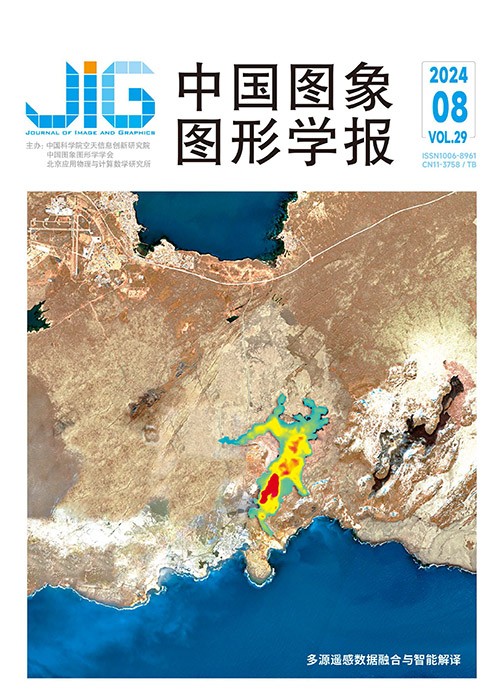
面向无人机海岸带生态系统监测的语义分割基准数据集
王胜科1, 王贤栋1, 曲亮2, 姚凤芹1, 刘莹莹1, 李聪慧1, 王玉瑱1, 仲国强1(1.中国海洋大学信息科学与工程学部, 青岛 266100;2.国家海洋局北海环境监测中心, 青岛 266033) 摘 要
目的 海岸带生态系统的监测是维护生态平衡和可持续发展的重要任务。语义分割技术在遥感影像中的应用为海岸带生态系统的精准监测提供了有效手段。然而,目前该领域仍面临一个挑战,即缺乏公开的专门面向海岸带生态系统的语义分割基准数据集。方法 受到自然环境和人为因素的共同影响,海岸带外部形态变化快,目前的卫星遥感和常规的人工测量、船载作业等监测方式已难以满足实时观测的要求。因此本文首先利用无人机对海岸带典型生态群落进行拍摄、采集和标注,构建了面向海岸带生态系统的基准数据集,名为OUC-UAV-SEG。接着,通过统计的方法,对OUC-UAV-SEG进行定量分析,并对数据集中存在的挑战进行了深入探讨。最后,使用典型视觉语义分割算法对OUC-UAV-SEG展开评估。结果 对OUC-UAV-SEG数据集进行了基准测试,评估了当前可用的语义分割算法在该数据集上的性能,并揭示了这些算法的局限性。结论 OUC-UAV-SEG数据集的建立为海岸带生态系统的监测提供了新的资源,有助于科学家、生态学家和决策者们更好地了解海岸带生态系统的现状和变化趋势,为海洋生态保护和管理提供更精确的信息。该数据集链接:https://github.com/OucCVLab/OUC-UAV-SEG。
关键词
Semantic segmentation benchmark dataset for coastal ecosystem monitoring based on unmanned aerial vehicle (UAV)
Wang Shengke1, Wang Xiandong1, Qu Liang2, Yao Fengqin1, Liu Yingying1, Li Conghui1, Wang Yuzhen1, Zhong Guoqiang1(1.Faculty of Information Science and Engineering, Ocean University of China, Qingdao 266100, China;2.North China Sea Environmental Monitoring Center, State Oceanic Administration, Qingdao 266033, China) Abstract
Objective The coastal ecosystem is a natural system composed of biological communities and their interactions with the environment, including typical coastal ecosystems such as mangroves, salt marshes, coral reefs, seagrass beds, oyster reefs, sandy shores, as well as complex ecosystems like estuaries and bays. These ecosystems play a crucial role in maintaining high-quality ecological environments and fostering rich marine biodiversity. A healthy coastal ecosystem is not only a crucial support for the sustainable economic development of China but also an essential component of the ecological security of the country.The application of semantic segmentation techniques in remote sensing imagery has provided an effective means for the precise monitoring of coastal ecosystems, which offers scientists, ecologists, and decision makers clear and highly comprehensive information to understand the current state and changing trends of coastal ecosystems. However, a significant challenge persists, that is, a specialized, comprehensive, and fine-grained data support system for coastal ecosystems is lacking, which causes difficulty in accurately understanding the distribution, area, and changes in ecosystems such as salt marshes, seagrass beds, and reed beds. This challenge has become a pressing issue in the current national marine ecological conservation efforts. Currently, the monitoring of coastal ecosystems relies primarily on satellite remote sensing and traditional surveying methods. Satellite remote sensing, with its unique advantages of all-weather, all-day, large-scale, and long-time observation, is widely used for monitoring marine ecology and resources through the analysis of satellite data. However, the spatial resolution of satellite remote sensing images has limitations, which introduces errors in cases that require fine-scale monitoring. For example, in narrow rivers, small wetland areas, or islands, the limited spatial resolution may result in unclear visibility of small features in the images. Traditional surveying methods often require professionals to conduct field surveys, which poses safety hazards in complex and risky environments. In addition, these methods are susceptible to human and natural factors, which leads to challenges in precise positioning and depiction, coupled with extended and inefficient monitoring cycles. Field surveys and mapping work for coastal ecosystems face significant challenges using traditional methods. Method This study utilized unmanned aerial vehicles (UAVs) to capture, collect, and annotate data from typical coastal ecosystems in real time for addressing urgent issues in marine ecological conservation. This effort led to the establishment of the OUC-UAV-SEG dataset, which includes various typical vegetation types found in coastal ecosystems, such as reed, seagrass beds, spartin, and crucially, addresses a key marine event—oil spills. Result In contrast to previous research that predominantly focused on individual dataset scenarios, such as spartin or oil spills, using traditional remote sensing methods for data analysis, this study stands out by using statistical methods to conduct a detailed quantitative analysis of OUC-UAV-SEG, which covers various categories and their respective quantities. In discussing the challenges posed by the dataset, including the discrete clustered morphology of eelgrass, interlaced spiderweb-like oil spills, fragile tubular Sargassum, and mottled tufted seagrass beds, existing segmentation algorithms exhibited suboptimal performance in handling these distinctive features. Finally, classical visual semantic segmentation algorithms were applied to evaluate OUC-UAV-SEG by conducting benchmark tests to assess the performance of currently available semantic segmentation algorithms on this dataset and revealing their limitations. Conclusion The establishment of the OUC-UAV-SEG dataset marks a significant step forward in providing a novel resource for monitoring coastal ecosystems. This dataset empowers scientists, ecologists, and decision makers with a more comprehensive understanding of the current conditions and evolving trends in coastal ecosystems. These insights are crucial for furnishing more accurate information to support marine ecological conservation and management efforts, which holds positive significance. Future efforts will focus on expanding the diversity of the dataset by collecting data on marine ecological environments under more extensive geographic and meteorological conditions to comprehensively reflect ecosystem diversity. Furthermore, by regularly organizing workshops and challenges, the aim is to advance cutting-edge research in the field of coastal ecosystem monitoring. Finally, active use of social media and other channels will be employed to engage with the public for raising awareness of marine environmental issues and inspiring more people to participate in the monitoring and protection of coastal ecosystems. For comprehensive details about this dataset, please refer to the project link:https://github.com/OucCVLab/OUC-UAV-SEG.
Keywords
coastal ecosystem remote sensing unmanned aerial vehicle (UAV) benchmark dataset semantic segmentation
|



 中国图象图形学报 │ 京ICP备05080539号-4 │ 本系统由
中国图象图形学报 │ 京ICP备05080539号-4 │ 本系统由